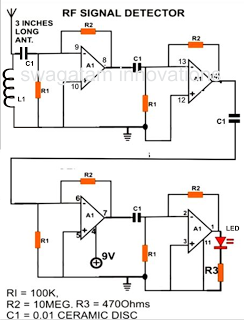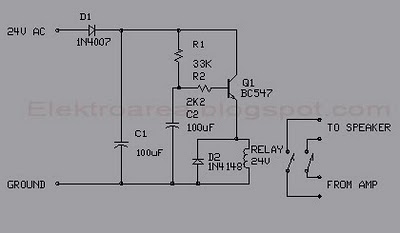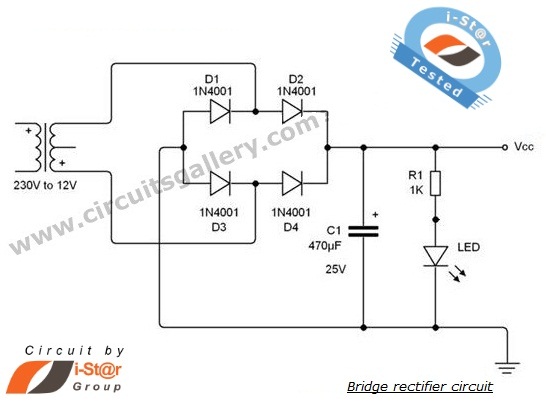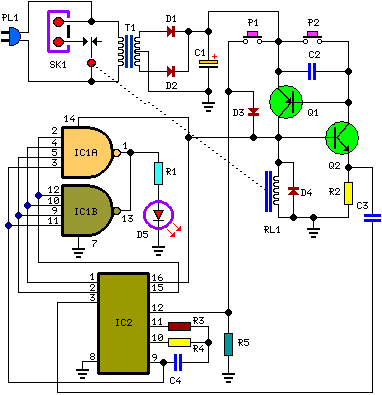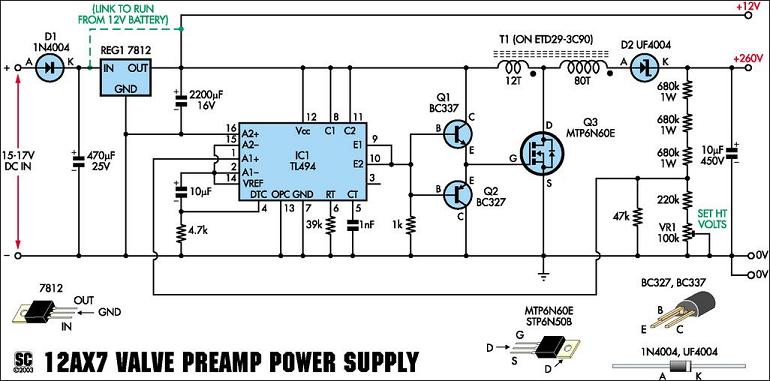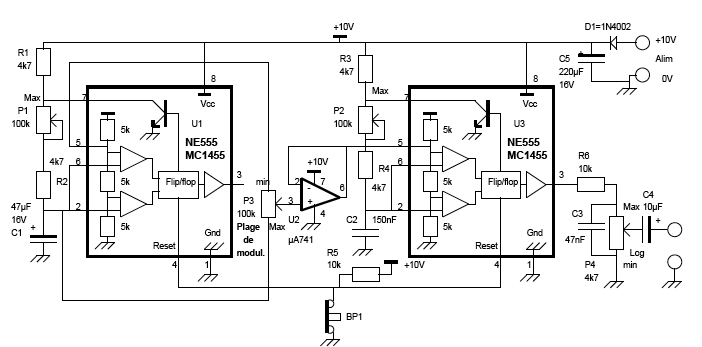
Motorcycle and Car Battery Tester Circuit
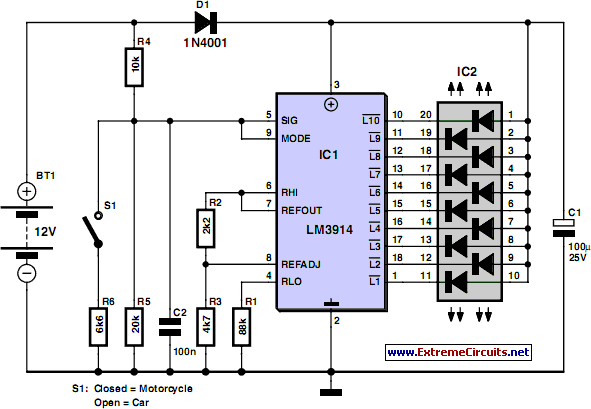
Camping today often involves various electronic accessories for daily activities or entertainment. Typically, a portable battery charger and a power inverter are used to ensure a well-organized campsite where both adults and children can comfortably use their electronic devices. With rechargeable lead-acid batteries, it is always beneficial—if not essential—to determine whether the power source being carried on the trip is sufficient and requires recharging. This same setup is also useful when traveling by car or motorcycle, as it can check the status of a 12V (car) or 6V (motorcycle) battery. Although the circuit draws minimal power, preventing significant depletion of the battery under test, it should not be left connected permanently. The circuit utilizes the LM3914 integrated circuit (IC1) to display the voltage level. The LED readout provides a battery status indication: when the top LED lights up, the battery is fully charged; when the bottom LED lights up, the battery requires charging. Switch S1 allows for selection between 12V and 6V operation. A series diode, D1, protects the bargraph driver from reverse voltage. A color-coded display with individual LEDs could be used instead of the common-anode bargraph display for better visibility of the battery's status.
The circuit described serves as a voltage monitoring system for lead-acid batteries commonly used in camping and recreational vehicles. It is designed to provide a visual indication of the battery's charge state, enhancing the usability of electronic devices in outdoor settings. The LM3914 integrated circuit functions as a bargraph driver, allowing for clear and intuitive voltage readings through a series of LEDs.
The circuit operates on two voltage levels, 6V and 12V, making it versatile for different applications, such as monitoring car and motorcycle batteries. The inclusion of switch S1 facilitates easy toggling between these two modes, ensuring accurate readings based on the specific battery type. The status indication provided by the LED array is straightforward: multiple LEDs illuminate to represent different charge levels, with the top LED indicating a full charge and the bottom LED signaling the need for recharging.
Protection against reverse voltage is a critical feature in this design, accomplished through diode D1, which safeguards the LM3914 from potential damage caused by incorrect connections. The option to implement a color-coded LED display instead of a traditional bargraph enhances the user experience by improving the visibility of battery status, particularly in low-light conditions typically encountered during camping trips.
This circuit not only aids in managing power for electronic devices but also contributes to the overall safety and reliability of battery usage in outdoor environments. It is a practical solution for campers who wish to maintain access to electronic devices while ensuring their batteries are adequately monitored and maintained.Going camping nowadays involves demography lots of cyberbanking accessories whether for day to day active or for fun and entertainment. Most of the time a answerable advance acerbic array and a ability inverter would be acclimated to ensure a calmly organized anniversary area alluringly the adult and the accouchement affably use their electric and
cyberbanking gear! With rechargeable lead-acid batteries it`s consistently advantageous - if not capital - to actuate whether the ability antecedent you`re carriage forth on your campaign is accident accommodation and needs to be topped up. The aforementioned ambit would additionally appear in accessible back activity on a car or motorbike cruise as it can analysis the cachet of a 12 V (car) or a 6 V (motorcycle) battery.
Although the ambit draws so little ability that it will not acutely amount the array beneath test, it should not be larboard affiliated permanently. The ambit employs the accustomed LM3914 (IC1) to affectation the voltage level. The LED readout creates a array cachet readout: back the top LED lights, the array is absolutely charged.
Back the basal LED lights, the array needs approaching charging! Switch S1 selects amid 12 V and 6 V operation. A alternation diode, D1, protects the bargraph disciplinarian from about-face accumulation voltage. A color-coded affectation with alone LEDs could be acclimated instead of the common-anode bargraph affectation for bigger adumbration of the accompaniment of the battery. 🔗 External reference
The circuit described serves as a voltage monitoring system for lead-acid batteries commonly used in camping and recreational vehicles. It is designed to provide a visual indication of the battery's charge state, enhancing the usability of electronic devices in outdoor settings. The LM3914 integrated circuit functions as a bargraph driver, allowing for clear and intuitive voltage readings through a series of LEDs.
The circuit operates on two voltage levels, 6V and 12V, making it versatile for different applications, such as monitoring car and motorcycle batteries. The inclusion of switch S1 facilitates easy toggling between these two modes, ensuring accurate readings based on the specific battery type. The status indication provided by the LED array is straightforward: multiple LEDs illuminate to represent different charge levels, with the top LED indicating a full charge and the bottom LED signaling the need for recharging.
Protection against reverse voltage is a critical feature in this design, accomplished through diode D1, which safeguards the LM3914 from potential damage caused by incorrect connections. The option to implement a color-coded LED display instead of a traditional bargraph enhances the user experience by improving the visibility of battery status, particularly in low-light conditions typically encountered during camping trips.
This circuit not only aids in managing power for electronic devices but also contributes to the overall safety and reliability of battery usage in outdoor environments. It is a practical solution for campers who wish to maintain access to electronic devices while ensuring their batteries are adequately monitored and maintained.Going camping nowadays involves demography lots of cyberbanking accessories whether for day to day active or for fun and entertainment. Most of the time a answerable advance acerbic array and a ability inverter would be acclimated to ensure a calmly organized anniversary area alluringly the adult and the accouchement affably use their electric and
cyberbanking gear! With rechargeable lead-acid batteries it`s consistently advantageous - if not capital - to actuate whether the ability antecedent you`re carriage forth on your campaign is accident accommodation and needs to be topped up. The aforementioned ambit would additionally appear in accessible back activity on a car or motorbike cruise as it can analysis the cachet of a 12 V (car) or a 6 V (motorcycle) battery.
Although the ambit draws so little ability that it will not acutely amount the array beneath test, it should not be larboard affiliated permanently. The ambit employs the accustomed LM3914 (IC1) to affectation the voltage level. The LED readout creates a array cachet readout: back the top LED lights, the array is absolutely charged.
Back the basal LED lights, the array needs approaching charging! Switch S1 selects amid 12 V and 6 V operation. A alternation diode, D1, protects the bargraph disciplinarian from about-face accumulation voltage. A color-coded affectation with alone LEDs could be acclimated instead of the common-anode bargraph affectation for bigger adumbration of the accompaniment of the battery. 🔗 External reference
Warning: include(partials/cookie-banner.php): Failed to open stream: Permission denied in /var/www/html/nextgr/view-circuit.php on line 713
Warning: include(): Failed opening 'partials/cookie-banner.php' for inclusion (include_path='.:/usr/share/php') in /var/www/html/nextgr/view-circuit.php on line 713
